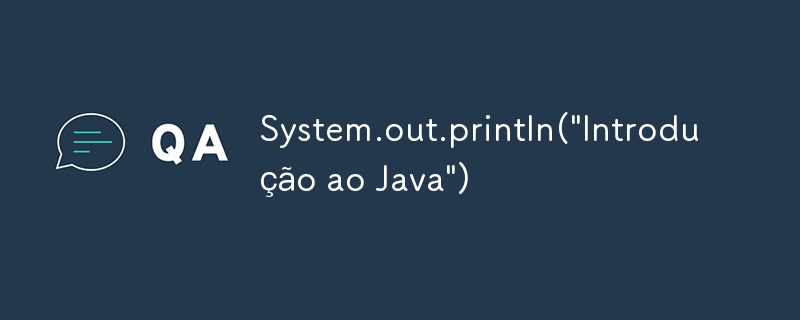Home >Java >javaTutorial >System.out.println(\'Introduction to Java\')
System.out.println(\'Introduction to Java\')
- WBOYWBOYWBOYWBOYWBOYWBOYWBOYWBOYWBOYWBOYWBOYWBOYWBOriginal
- 2024-07-18 05:28:19526browse

public class HelloWorld {
public static void main(String[] args) {
System.out.println(\Introduction to Java\)"Hello, World!");
}
}
Verbose Language?
When we start studying Java and look at the code above, we may be a little scared by the number of words needed to print a simple Hello, World!. This can sometimes give the impression that it is a difficult language, which can discourage beginners from exploring it in more depth right from the start, creating a kind of prejudice without a deeper understanding of the language.
What Are These Words: public, class, static, void, main...
When we execute the above code, the Java Virtual Machine (JVM) looks for the main block and executes it. Typically, applications only have a single method of this type, as the name suggests: the application's main method, the starting point.
public is an access modifier that indicates the type of the HelloWorld class, allowing it to be accessed by any other package. In addition to this, there are protected and private modifiers, which will be discussed at another time.
class is the reserved word used to indicate a class, which in this case is HelloWorld. It is important to remember that the class name must match the name of the Java file where it is defined (in this case, HelloWorld.java).
static indicates that the main method belongs to the HelloWorld class itself and not to specific instances of that class. This means that the method can be called without having to create an object of the HelloWorld class.
void is the return type of the main method, meaning that the method does not return any value.
String[] args is the main method parameter. args is an array of strings that allows you to pass command line arguments to the Java program when it runs.
Understanding these definitions, we can understand that Java is an imperative language. Unlike declarative languages, where we say what we want and the language decides how to carry out the process, in imperative languages we need to provide instructions on how the process should be carried out. This provides us with some benefits, such as:
Detailed control of the execution flow: In imperative languages, we have explicit control over how the program executes each step. This is useful for programmers to understand exactly what is happening and to optimize code performance.
Ease of debugging errors: As we specify each step of the process, it is easier to identify and correct errors when they occur. Error messages often clearly indicate where a problem occurred in the imperative code.
Performance: In many cases, imperative languages allow for more direct and efficient optimizations, as the programmer has control over how system resources are used.
Adaptability to different contexts: Imperative programming is quite flexible and can be adapted to solve a wide range of problems, from the simplest to complex applications.
State control: In imperative languages, the state of the program is explicitly manipulated through variables and data structures. This makes it easier to manage mutable data and control the internal state of the program.
The fourth item takes us to a very important concept that we will cover at another time: Object Orientation.
In this article, we explore how the simple act of printing "Hello, World!" in Java introduces us to fundamental concepts of the language. Analysis of the keywords used in the code reveals the basic structure of a Java program and its meaning within the context of imperative programming.
By understanding the imperative programming principles presented here — flow control, ease of error debugging, performance optimization, adaptability, and state management — beginning programmers are equipped with essential tools for building and understanding robust and efficient Java programs .
In future articles, we will explore more advanced concepts, such as object orientation, which further expand Java's capabilities and open doors for the development of complex and scalable applications.
Now that you understand the fundamentals, you are ready to explore the vast universe of Java programming deeper. Stay motivated and keep exploring new concepts to improve your skills as a developer.
I hope this article was useful for you to start your journey in the Java language. If you have any questions or suggestions, feel free to share them in the comments below.
The above is the detailed content of System.out.println(\'Introduction to Java\'). For more information, please follow other related articles on the PHP Chinese website!

